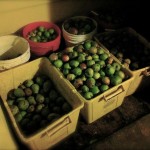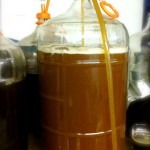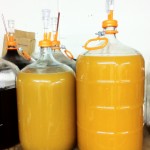Parkways Cider
Monday, September 26th, 2011
It’s time to make cider again!
 The fruit
The fruit
In 2009, we made separate batches of pear and apple cider. This time around, we just mixed all the fruit together from the start. All of it is organic and much of it was donated from friends in the neighborhood. If you have an old apple tree in your yard, but the apples are green and “mealy”… don’t ignore it. What you probably have are cider apples – the kind Johnny Appleseed would be proud of!
I didn’t count, but if I had to guess – the mixture was approximately:
- 50% Cider Apples
- 30% Gravenstein Apples (windfalls)
- 10% Bartlet Pears (windfalls)
- 5% Crabapples
- 5% Asian Pears
 Grinding and Pressing
Grinding and Pressing
We decided to make the cider during the Sunday Parkways event.
My plan was to build a hydraulic press this year, but I ran out of time. So, once again, we used the small, bright-red screw press (which is really starting to fall apart). It is not very efficient, but looks like a classic press. This seemed to attract a lot of people as they passed by.
It ended up being a great idea and lots of the neighborhood kids lined up to help. However, they also ended up drinking quite a bit of the fresh cider. By the end of the day, we probably lost 3-4 gallons as the children returned again and again to refill their cups. Still, 8+ gallons ended up in the carboys, which was more then I experted.
 Setting the Cider
Setting the Cider
The next day, the cider was distributed to 3 buckets. It’s measured gravity was above 1.060 – so, water was added to dilute the OG to about 1.045. If it ferments out completely, this should give a final ABV around 5%.
The diluted volume of the cider is now around 12 gallons (3 buckets with 4 gallons each). To each was added:
- 1/3 tsp wine yeast nutrient
- 2 tsp pectic enzyme (to break down haze)
- 5 crushed campden tablets(to sterilize)
Only 1 campden/gallon is usually recommended. However, I had just added tap water. The extra tablet will help to quickly eliminate the free chlorine.
24 hours later, a pack of pasteur champagne yeast (yellow pack) was added to each bucket.
 First Racking
First Racking
After a week of very active fermentation, the cider started to settle down. It also lost the rather large head of foam that had been accumulating. Time to rack!
The three buckets ended up filling a 5 and a 6 gallon carboy.
It smelled good – though still quite yeasty, as you might expect. I did not check the gravity this time. Lets’ let it ferment out a little longer.
You will also notice that it has lightened up quite a bit. Actually, it was fairly clear before the racking – a medium/light yellow. However, I stirred up a bunch of sediment during the transfer, so right now it is very hazy.

Bryan Says:
The swap meet grape press comes in handy again! Nice.